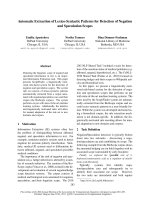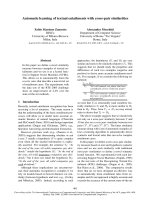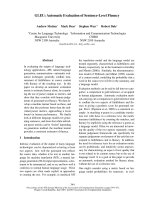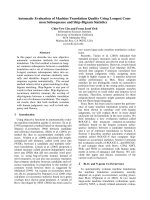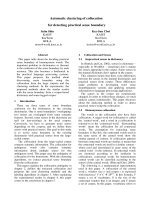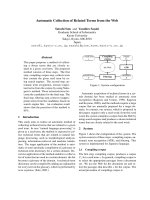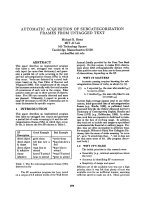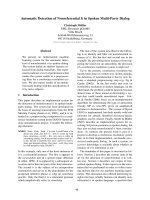Báo cáo khoa học: "Automatic Acquisition of Ranked Qualia Structures from the Web" potx
Bạn đang xem bản rút gọn của tài liệu. Xem và tải ngay bản đầy đủ của tài liệu tại đây (191.92 KB, 8 trang )
Proceedings of the 45th Annual Meeting of the Association of Computational Linguistics, pages 888–895,
Prague, Czech Republic, June 2007.
c
2007 Association for Computational Linguistics
Automatic Acquisition of Ranked Qualia Structures from the Web
1
Philipp Cimiano
Inst. AIFB, University of Karlsruhe
Englerstr. 11, D-76131 Karlsruhe
Johanna Wenderoth
Inst. AIFB, University of Karlsruhe
Englerstr. 11, D-76131 Karlsruhe
Abstract
This paper presents an approach for the au-
tomatic acquisition of qualia structures for
nouns from the Web and thus opens the pos-
sibility to explore the impact of qualia struc-
tures for natural language processing at a
larger scale. The approach builds on ear-
lier work based on the idea of matching spe-
cific lexico-syntactic patterns conveying a
certain semantic relation on the World Wide
Web using standard search engines. In our
approach, the qualia elements are actually
ranked for each qualia role with respect to
some measure. The specific contribution of
the paper lies in the extensive analysis and
quantitative comparison of different mea-
sures for ranking the qualia elements. Fur-
ther, for the first time, we present a quan-
titative evaluation of such an approach for
learning qualia structures with respect to a
handcrafted gold standard.
1 Introduction
Qualia structures have been originally introduced
by (Pustejovsky, 1991) and are used for a variety
of purposes in natural language processing (NLP),
such as for the analysis of compounds (Johnston and
Busa, 1996) as well as co-composition and coercion
(Pustejovsky, 1991), but also for bridging reference
resolution (Bos et al., 1995). Further, it has also
1
The work reported in this paper has been supported by the
X-Media project, funded by the European Commission under
EC grant number IST-FP6-026978 as well by the SmartWeb
project, funded by the German Ministry of Research. Thanks
to all our colleagues for helping to evaluate the approach.
been argued that qualia structures and lexical seman-
tic relations in general have applications in informa-
tion retrieval (Voorhees, 1994; Pustejovsky et al.,
1993). One major bottleneck however is that cur-
rently qualia structures need to be created by hand,
which is probably also the reason why there are al-
most no practical NLP systems using qualia struc-
tures, but a lot of systems relying on publicly avail-
able resources such as WordNet (Fellbaum, 1998)
or FrameNet (Baker et al., 1998) as source of lex-
ical/world knowledge. The work described in this
paper addresses this issue and presents an approach
to automatically learning qualia structures for nouns
from the Web. The approach is inspired in recent
work on using the Web to identify instances of a re-
lation of interest such as in (Markert et al., 2003) and
(Etzioni et al., 2005). These approaches rely on a
combination of the usage of lexico-syntactic pattens
conveying a certain relation of interest as described
in (Hearst, 1992) with the idea of using the web as a
big corpus (cf. (Kilgariff and Grefenstette, 2003)).
Our approach directly builds on our previous work
(Cimiano and Wenderoth, 2005) an adheres to the
principled idea of learning ranked qualia structures.
In fact, a ranking of qualia elements is useful as it
helps to determine a cut-off point and as a reliabil-
ity indicator for lexicographers inspecting the qualia
structures. In contrast to our previous work, the fo-
cus of this paper lies in analyzing different measures
for ranking the qualia elements in the automatically
acquired qualia structures. We also introduce ad-
ditional patterns for the agentive role which make
use of wildcard operators. Further, we present a
gold standard for qualia structures created for the 30
words used in the evaluation of Yamada and Bald-
win (Yamada and Baldwin, 2004). The evaluation
888
presented here is thus much more extensive than our
previous one (Cimiano and Wenderoth, 2005), in
which only 7 words were used. We present a quanti-
tative evaluation of our approach and a comparison
of the different ranking measures with respect to this
gold standard. Finally, we also provide an evaluation
in which test persons were asked to inspect and rate
the learned qualia structures a posteriori. The paper
is structured as follows: Section 2 introduces qualia
structures for the sake of completeness and describes
the specific structures we aim to acquire. Section
3 describes our approach in detail, while Section 4
discusses the ranking measures used. Section 5 then
presents the gold standard as well as the qualitative
evaluation of our approach. Before concluding, we
discuss related work in Section 6.
2 Qualia Structures
In the Generative Lexicon (GL) framework (Puste-
jovsky, 1991), Pustejovsky reused Aristotle’s basic
factors (i.e. the material, agentive, formal and final
causes) for the description of the meaning of lexi-
cal elements. In fact, he introduced so called qualia
structures by which the meaning of a lexical ele-
ment is described in terms of four roles: Constitutive
(describing physical properties of an object, i.e. its
weight, material as well as parts and components),
Agentive (describing factors involved in the bringing
about of an object, i.e. its creator or the causal chain
leading to its creation), Formal (describing proper-
ties which distinguish an object within a larger do-
main, i.e. orientation, magnitude, shape and dimen-
sionality), and Telic (describing the purpose or func-
tion of an object).
Most of the qualia structures used in (Pustejovsky,
1991) however seem to have a more restricted inter-
pretation. In fact, in most examples the Constitutive
role seems to describe the parts or components of an
object, while the Agentive role is typically described
by a verb denoting an action which typically brings
the object in question into existence. The Formal
role normally consists in typing information about
the object, i.e. its hypernym. In our approach, we
aim to acquire qualia structures according to this re-
stricted interpretation.
3 Automatically Acquiring Qualia
Structures
Our approach to learning qualia structures from the
Web is on the one hand based on the assumption
that instances of a certain semantic relation can be
acquired by matching certain lexico-syntactic pat-
terns more or less reliably conveying the relation
of interest in line with the seminal work of Hearst
(Hearst, 1992), who defined patterns conveying hy-
ponym/hypernym relations. However, it is well
known that Hearst-style patterns occur rarely, such
that matching these patterns on the Web in order
to alleviate the problem of data sparseness seems a
promising solution. In fact, in our case we are not
only looking for the hypernym relation (comparable
to the Formal-role) but for similar patterns convey-
ing a Constitutive, Telic or Agentive relation. Our
approach consists of 5 phases; for each qualia term
(the word we want to find the qualia structure for)
we:
1. generate for each qualia role a set of so called
clues, i.e. search engine queries indicating the
relation of interest,
2. download the snippets (abstracts) of the 50 first
web search engine results matching the generated
clues,
3. part-of-speech-tag the downloaded snippets,
4. match patterns in the form of regular expressions
conveying the qualia role of interest, and
5. weight and rank the returned qualia elements ac-
cording to some measure.
The patterns in our pattern library are actually
tuples (p, c) where p is a regular expression de-
fined over part-of-speech tags and c a function c :
string → string called the clue. Given a nomi-
nal n and a clue c, the query c(n) is sent to the web
search engine and the abstracts of the first m docu-
ments matching this query are downloaded. Then
the snippets are processed to find matches of the
pattern p. For example, given the clue f (x) =
“such as p(x)
and the qualia term computer we
would download m abstracts matching the query
f(computer), i.e. ”such as computers”. Hereby p(x)
is a function returning the plural form of x. We im-
plemented this function as a lookup in a lexicon in
which plural nouns are mapped to their base form.
With the use of such clues, we thus download a num-
889
ber of snippets returned by the web search engine in
which a corresponding regular expression will prob-
ably be matched, thus restricting the linguistic anal-
ysis to a few promising pages. The downloaded ab-
stracts are then part-of-speech tagged using QTag
(Tufis and Mason, 1998). Then we match the corre-
sponding pattern p in the downloaded snippets thus
yielding candidate qualia elements as output. The
qualia elements are then ranked according to some
measure (compare Section 4), resulting in what we
call Ranked Qualia Structures (RQSs). The clues
and patterns used for the different roles can be found
in Tables 1 - 4. In the specification of the clues, the
function a(x) returns the appropriate indefinite arti-
cle – ‘a’ or ‘an’ – or no article at all for the noun x.
The use of an indefinite article or no article at all ac-
counts for the distinction between countable nouns
(e.g. such as knife) and mass nouns (e.g. water).
The choice between using the articles ’a’, ’an’ or
no article at all is determined by issuing appropriate
queries to the web search engine and choosing the
article leading to the highest number of results. The
corresponding patterns are then matched in the 50
snippets returned by the search engine for each clue,
thus leading to up to 50 potential qualia elements per
clue and pattern
2
. The patterns are actually defined
over part-of-speech tags. We indicate POS-tags in
square brackets. However, for the sake of simplic-
ity, we largely omit the POS-tags for the lexical ele-
ments in the patterns described in Tables 1 - 4. Note
that we use traditional regular expression operators
such as ∗ (sequence), + (sequence with at least one
element) | (alternative) and ? (option). In general,
we define a noun phrase (NP) by the following reg-
ular expression: NP:=[DT]? ([JJ])+? [NN(S?)])+
3
,
where the head is the underlined expression, which
is lemmatized and considered as a candidate qualia
element. For all the patterns described in this sec-
tion, the underlined part corresponds to the extracted
qualia element. In the patterns for the formal role
(compare Table 1), NP
QT
is a noun phrase with the
qualia term as head, whereas NP
F
is a noun phrase
with the potential qualia element as head. For the
constitutive role patterns, we use a noun phrase vari-
2
For the co nstitutive role these can be even more due to the
fact that we consider enumerations.
3
Though Qtag uses another part-of-speech tagset, we rely on
the well-known Penn Treebank tagset for presentation purposes.
Clue Pattern
Singular
“a(x) x is a kind of ” NP
QT
is a kind of NP
F
“a(x) x is” NP
QT
is a kind of NP
F
“a(x) x and other” NP
QT
(,)? and other NP
F
“a(x) x or other” NP
QT
(,)? or other NP
F
Plural
“such as p(x)” NP
F
such as NP
QT
“p(x) and other” NP
QT
(,)? and other NP
F
“p(x) or other” NP
QT
(,)? or other NP
F
“especially p(x)” NP
F
(,)? especially NP
QT
“including p(x)” NP
F
(,)? including NP
QT
Table 1: Clues and Patterns for the Formal role
ant NP’ defined by the regular expression NP’:=
(NP of[IN])? NP (, NP)* ((,)? (and|or) NP)?
, which
allows to extract enumerations of constituents (com-
pare Table 2). It is important to mention that in the
case of expressions such as ”a car comprises a fixed
number of basic components”, ”data mining com-
prises a range of data analysis techniques”, ”books
consist of a series of dots”, or ”a conversation is
made up of a series of observable interpersonal ex-
changes”, only the NP after the preposition ’of’ is
taken into account as qualia element. The Telic Role
is in principle acquired in the same way as the For-
mal and Constitutive roles with the exception that
the qualia element is not only the head of a noun
phrase, but also a verb or a verb followed by a noun
phrase. Table 3 gives the corresponding clues and
patterns. In particular, the returned candidate qualia
elements are the lemmatized underlined expressions
in PURP:=[VB] NP | NP | be[VBD]. Finally, con-
cerning the clues and patterns for the agentive role
shown in Table 4, it is interesting to emphasize the
usage of the adjectives ’new’ and ’complete’. These
adjectives are used in the patterns to increase the ex-
pectation for the occurrence of a creation verb. Ac-
cording to our experiments, these patterns are in-
deed more reliable in finding appropriate qualia ele-
ments than the alternative version without the adjec-
tives ‘new’ and ‘complete’. Note that in all patterns,
the participle (VBD) is always reduced to base form
(VB) via a lexicon lookup. In general, the patterns
have been crafted by hand, testing and refining them
in an iterative process, paying attention to maximize
their coverage but also accuracy. In the future, we
plan to exploit an approach to automatically learn
the patterns.
890
Clue Pattern
Singular
“a(x) x is made up of ” NP
QT
is made up of NP’
C
“a(x) x is made of” NP
QT
is made of NP’
C
“a(x) x comprises” NP
QT
comprises (of)? NP’
C
“a(x) x consists of” NP
QT
consists of NP’
C
Plural
“p(x) are made up of ” NP
QT
is made up of NP’
C
“p(x) are made of” NP
QT
are made of NP’
C
“p(x) comprise” NP
QT
comprise (of)? NP’
C
“p(x) consist of” NP
QT
consist of NP’
C
Table 2: Clues and Patterns for the Constitutive Role
Clue Pattern
Singular
“purpose of a(x) x is” purpose of (a|an) x is (to)? PURP
“a(x) is used to” (a|an) x is used to PURP
Plural
“purpose of p(x) is” purpose of p(x) is (to)? PURP
“p(x) are used to” p(x) are used to PURP
Table 3: Clues and Patterns for the Telic Role
4 Ranking Measures
In order to rank the different qualia elements of a
given qualia structure, we rely on a certain ranking
measure. In our experiments, we analyze four differ-
ent ranking measures. On the one hand, we explore
measures which use the Web to calculate the corre-
lation strength between a qualia term and its qualia
elements. These measures are Web-based versions
of the Jaccard coefficient (Web-Jac), the Pointwise
Mutual Information (Web-PMI) and the conditional
probability (Web-P). We also present a version of
the conditional probability which does not use the
Web but merely relies on the counts of each qualia
element as produced by the lexico-syntactic patterns
(P-measure). We describe these measures in the fol-
lowing.
4.1 Web-based Jaccard Measure (Web-Jac)
Our web-based Jaccard (Web-Jac) measure relies on
the web search engine to calculate the number of
documents in which x and y co-occur close to each
other, divided by the number of documents each one
occurs, i.e.
Web-Jac(x, y) :=
Hits(x ∗ y)
Hits(x) + Hits(y) − Hits(x AND y)
So here we are relying on the wildcard operator ’*’
provided by the Google search engine API
4
. Though
4
In fact, for the experiments described in this paper we rely
on the Google API.
Clue Pattern
Singular
“to * a(x) new x” to [RB]? [VB] a? new x
“to * a(x) complete x” to [RB]? [VB] a? complete x
“a(x) new has been *” a? new x has been [VBD]
“a(x) complete x has been *” a? complete has been [VBD]
Plural
“to * new p(x)” to [RB]? [VB] new p(x)
“to * complete p(x)” to [RB]? [VB] complete p(x)
Table 4: Clues and Patterns for the Agentive Role
the specific function of the ’*’ operator as imple-
mented by Google is actually unknown, the behavior
is similar to the formerly available Altavista NEAR
operator
5
.
4.2 Web-based Pointwise Mutual Information
(Web-PMI)
In line with Magnini et al. (Magnini et al., 2001),
we define a PMI-based measure as follows:
W eb − P MI(x, y) := log
2
Hits(x AND y) MaxPages
Hits(y) Hits(y)
where maxPages is an approximation for the maxi-
mum number of English web pages
6
.
4.3 Web-based Conditional Probability
(Web-P)
The conditional probability P (x|y) is essentially
the probability that x is true given that y is true, i.e.
Web-P(x, y) := P (x|y) =
P (x,y)
P (y)
=
Hits(x NEAR y)
Hits(y)
whereby Hits(x NEAR y) is calculated as
mentioned above using the ‘*’ operator. In contrast
to the measures described above, this one is asym-
metric so that order indeed matters. Given a qualia
term qt as well as a qualia element qe we actually
calculate Web-P(qe,qt) for a specific qualia role.
4.4 Conditional Probability (P)
The non web-based conditional probability essen-
tially differs from the Web-based conditional prob-
ability in that we only rely on the qualia elements
5
Initial experiments indeed showed that counting pages in
which the two terms occur near each other in contrast to count-
ing pages in which they merely co-occur improved the results
of the Jaccard measure by about 15%.
6
We determine this number experimentally as the number of
web pages containing the words ’the’ and ’and’.
891
matched. On the basis of these, we then calculate
the probability of a certain qualia element given a
certain role on the basis of its frequency of appear-
ance with respect to the total number of qualia ele-
ments derived for this role, i.e. we simply calculate
P (qe|qr, qt) on the basis of the derived occurrences,
where qt is a given qualia term, qr is the specific
qualia role and qe is a qualia element.
5 Evaluation
In this section, we first of all describe our evaluation
measures. Then we describe the creation of the gold
standard. Further, we present the results of the com-
parison of the different ranking measures with re-
spect to the gold standard. Finally, we present an ‘a
posteriori’ evaluation showing that the qualia struc-
tures learned are indeed reasonable.
5.1 Evaluation Measures
As our focus is to compare the different measures
described above, we need to evaluate their corre-
sponding rankings of the qualia elements for each
qualia structure. This is a similar case to evaluat-
ing the ranking of documents within information re-
trieval systems. In fact, as done in standard infor-
mation retrieval research, our aim is to determine
for each ranking the precision/recall trade-off when
considering more or less of the items starting from
the top of the ranked list. Thus, we evaluate our ap-
proach calculating precision at standard recall levels
as typically done in information retrieval research
(compare (Baeza-Yates and Ribeiro-Neto, 1999)).
Hereby the 11 standard recall levels are 0%, 10%,
20%, 30%, 40%, 50%, 60%, 70%, 80%, 90% and
100%. Further, precision at these standard recall
levels is calculated by interpolating recall as fol-
lows: P (r
j
) = max
r
j
≤r≤r
j+1
P (r), where, j ∈
{0, 0.1, 0.2, 0.3, 0.4, 0.5, 0.6, 0.7, 0.8, 0.9, 1}. This
way we can compare the precision over standard re-
call figures for the different rankings, thus observing
which measure leads to the better precision/recall
trade-off.
In addition, in order to provide one single value
to compare, we also calculate the F-Measure cor-
responding to the best precision/recall trade-off for
each ranking measure. This F-Measure thus corre-
sponds to the best cut-off point we can find for the
items in the ranked list. In fact, we use the well-
known F
1
measure corresponding to the harmonic
mean between recall and precision:
F
1
:= max
j
2 P (r
j
) r
j
P (r
j
) + r
j
As a baseline, we compare our results to a naive
strategy without any ranking, i.e. we calculate the
F-Measure for all the items in the (unranked) list of
qualia elements. Consequently, for the rankings to
be useful, they need to yield higher F-Measures than
this naive baseline.
5.2 Gold Standard
The gold standard was created for the 30 words used
already in the experiments described in (Yamada and
Baldwin, 2004): accounting, beef, book, car, cash,
clinic, complexity, counter, county, delegation, door,
estimate, executive, food, gaze, imagination, inves-
tigation, juice, knife, letter, maturity, novel, phone,
prisoner, profession, review, register, speech, sun-
shine, table. These words were distributed more or
less uniformly between 30 participants of our exper-
iment, making sure that three qualia structures for
each word were created by three different subjects.
The participants, who were all non-linguistics, re-
ceived a short instruction in the form of a short pre-
sentation explaining what qualia structures are, the
aims of the experiment as well as their specific task.
They were also shown some examples for qualia
structures for words not considered in our experi-
ments. Further, they were asked to provide between
5 and 10 qualia elements for each qualia role. The
participants completed the test via e-mail. As a first
interesting observation, it is worth mentioning that
the participants only delivered 3-5 qualia elements
on average depending on the role in question. This
shows already that participants had trouble in find-
ing different qualia elements for a given qualia role.
We calculate the agreement for the task of specify-
ing qualia structures for a particular term and role as
the averaged pairwise agreement between the qualia
elements delivered by the three subjects, henceforth
S
1
, S
2
and S
3
as:
Agr :=
|S
1
∩S
2
|
|S
1
∪S
2
|
+
|S
1
∩S
3
|
|S
1
∪S
3
|
+
|S
2
∪S
3
|
|S
2
∩S
3
|
3
Averaging over all the roles and words, we get an
average agreement of 11.8%, i.e. our human test
892
subjects coincide in slightly more than every 10th
qualia element. This is certainly a very low agree-
ment and certainly hints at the fact that the task con-
sidered is certainly difficult. The agreement was
lowest (7.29%) for the telic role.
A further interesting observation is that the lowest
agreement is yielded for more abstract words, while
the agreement for very concrete words is reasonable.
For example, the five words with the highest agree-
ment are indeed concrete things: knife (31%), cash
(29%), juice (21%), car (20%) and door (19%). The
words with an agreement below 5% are gaze, pris-
oner, accounting, maturity, complexity and delega-
tion. In particular, our test subjects had substantial
difficulties in finding the purpose of such abstract
words. In fact, the agreement on the telic role is be-
low 5% for more than half of the words.
In general, this shows that any automatic ap-
proach towards learning qualia structures faces se-
vere limits. For sure, we can not expect the results
of an automatic evaluation to be very high. For ex-
ample, for the telic role of ‘clinic’, one test subject
specified the qualia element ‘cure’, while another
one specified ‘cure disease’, thus leading to a dis-
agreement in spite of the obvious agreement at the
semantic level. In this line, the average agreement
reported above has in fact to be regarded as a lower
bound for the actual agreement. Of course, our ap-
proach to calculating agreement is too strict, but in
absence of a clear and computable definition of se-
mantic agreement, it will suffice for the purposes of
this paper.
5.3 Gold Standard Evaluation
We ran experiments calculating the qualia structure
for each of the 30 words, ranking the resulting qualia
elements for each qualia structure using the different
measures described in Section 4.
Figure 1 shows the best F-Measure correspond-
ing to a cut-off leading to an optimal precision/recall
trade-off. We see that the P -measure performs best,
while the Web-P measure and the Web-Jac measure
follow at about 0.05 and 0.2 points distance. The
PMI-based measure indeed leads to the worst F-
Measure values.
Indeed, the P -measure delivered the best results
for the formal and agentive roles, while for the con-
stitutive and telic roles the Web-Jac measure per-
Figure 1: Average F
1
measure for the different rank-
ing measures
formed best. The reason why PMI performs so badly
is the fact that it favors too specific results which
are unlikely to occur as such in the gold standard.
For example, while the conditional probability ranks
highest: explore, help illustrate, illustrate and en-
rich for the telic role of novel, the PMI-based mea-
sure ranks highest: explore great themes, illustrate
theological points, convey truth, teach reading skills
and illustrate concepts. A series of significance tests
(paired Student’s t-test at an α-level of 0.05) showed
that the three best performing measures (P , Web-
P and Web-Jaccard) show no real difference among
them, while all three show significant difference to
the Web-PMI measure. A second series of signif-
icance tests (again paired Student’s t-test at an α-
level of 0.05) showed that all ranking measures in-
deed significantly outperform the baseline, which
shows that our rankings are indeed reasonable. In-
terestingly, there seems to be an interesting positive
correlation between the F-Measure and the human
agreement. For example, for the best performing
ranking measure, i.e. the P -measure, we get an av-
erage F-Measure of 21% for words with an agree-
ment over 5%, while we get an F-Measure of 9%
for words with an agreement below 5%. The rea-
son here probably is that those words and qualia ele-
ments for which people are more confident also have
a higher frequency of appearance on the Web.
5.4 A posteriori Evaluation
In order to check whether the automatically learned
qualia structures are reasonable from an intuitive
point of view, we also performed an a posteriori
893
evaluation in the lines of (Cimiano and Wenderoth,
2005). In this experiment, we presented the top 10
ranked qualia elements for each qualia role for 10
randomly selected words to the different test per-
sons. Here we only used the P -measure for rank-
ing as it performed best in our previous evaluation
with regard to the gold standard. In order to ver-
ify that our sample is not biased, we checked that
the F-Measure yielded by our 10 randomly selected
words (17.7%) does not differ substantially from the
overall average F-Measure (17.1%) to be sure that
we have chosen words from all F-Measure ranges.
In particular, we asked different test subjects which
also participated in the creation of the gold standard
to rate the qualia elements with respect to their ap-
propriateness for the qualia term using a scale from
0 to 3, whereby 0 means ’wrong’, 1 ’not totally
wrong’, 2 ’acceptable’ and 3 ’totally correct’. The
participants confirmed that it was easier to validate
existing qualia structures than to create them from
scratch, which already corroborates the usefulness
of our automatic approach. The qualia structure for
each of the 10 randomly selected words was vali-
dated independently by three test persons. In fact,
in what follows we always report results averaged
for three test subjects. Figure 2 shows the average
values for different roles. We observe that the con-
stitutive role yields the best results, followed by the
formal, telic and agentive roles (in this order). In
general, all results are above 2, which shows that
the qualia structures produced are indeed acceptable.
Though we do not present these results in more de-
tail due to space limitations, it is also interesting to
mention that the F-Measure calculated with respect
to the gold standard was in general highly correlated
with the values assigned by the human test subjects
in this a posteriori validation.
6 Related Work
Instead of matching Hearst-style patterns (Hearst,
1992) in a large text collection, some researchers
have recently turned to the Web to match these pat-
terns such as in (Markert et al., 2003) or (Etzioni et
al., 2005). Our approach goes further in that it not
only learns typing, superconcept or instance-of rela-
tions, but also Constitutive, Telic and Agentive rela-
tions.
Figure 2: Average ratings for each qualia role
There also exist approaches specifically aiming at
learning qualia elements from corpora based on ma-
chine learning techniques. Claveau et al. (Claveau
et al., 2003) for example use Inductive Logic Pro-
gramming to learn if a given verb is a qualia ele-
ment or not. However, their approach does no go
as far as learning the complete qualia structure for a
lexical element as in our approach. Further, in their
approach they do not distinguish between different
qualia roles and restrict themselves to verbs as po-
tential fillers of qualia roles.
Yamada and Baldwin (Yamada and Baldwin, 2004)
present an approach to learning Telic and Agentive
relations from corpora analyzing two different ap-
proaches: one relying on matching certain lexico-
syntactic patterns as in the work presented here, but
also a second approach consisting in training a max-
imum entropy model classifier. The patterns used
by (Yamada and Baldwin, 2004) differ substantially
from the ones used in this paper, which is mainly
due to the fact that search engines do not provide
support for regular expressions and thus instantiat-
ing a pattern as ’V[+ing] Noun’ is impossible in our
approach as the verbs are unknown a priori.
Poesio and Almuhareb (Poesio and Almuhareb,
2005) present a machine learning based approach to
classifying attributes into the six categories: qual-
ity, part, related-object, activity, related-agent and
non-attribute.
7 Conclusion
We have presented an approach to automatically
learning qualia structures from the Web. Such an
approach is especially interesting either for lexicog-
894
raphers aiming at constructing lexicons, but even
more for natural language processing systems re-
lying on deep lexical knowledge as represented by
qualia structures. In particular, we have focused
on learning ranked qualia structures which allow
to find an ideal cut-off point to increase the preci-
sion/recall trade-off of the learned structures. We
have abstracted from the issue of finding the appro-
priate cut-off, leaving this for future work. In partic-
ular, we have evaluated different ranking measures
for this purpose, showing that all of the analyzed
measures (Web-P, Web-Jaccard, Web-PMI and the
conditional probability) significantly outperformed
a baseline using no ranking measure. Overall, the
plain conditional probability P (not calculated over
the Web) as well as the conditional probability cal-
culated over the Web (Web-P) delivered the best re-
sults, while the PMI-based ranking measure yielded
the worst results. In general, our main aim has been
to show that, though the task of automatically learn-
ing qualia structures is indeed very difficult as shown
by our low human agreement, reasonable structures
can indeed be learned with a pattern-based approach
as presented in this paper. Further work will aim
at inducing the patterns automatically given some
seed examples, but also at using the automatically
learned structures within NLP applications. The cre-
ated qualia structure gold standard is available for
the community
7
.
References
R. Baeza-Yates and B. Ribeiro-Neto. 1999. Modern In-
formation Retrieval. Addison-Wesley.
C.F. Baker, C.J. Fillmore, and J.B. Lowe. 1998. The
Berkeley FrameNet Project. In Proceedings of COL-
ING/ACL’98, pages 86–90.
J. Bos, P. Buitelaar, and M. Mineur. 1995. Bridging as
coercive accomodation. In Working Notes of the Edin-
burgh Conference on Computational Logic and Natu-
ral Language Processing (CLNLP-95).
P. Cimiano and J. Wenderoth. 2005. Learning qualia
structures from the web. In Proceedings of the ACL
Workshop on Deep Lexical Acquisition, pages 28–37.
V. Claveau, P. Sebillot, C. Fabre, and P. Bouillon. 2003.
Learning semantic lexicons from a part-of-speech and
semantically tagged corpus using inductive logic pro-
gramming. Journal of Machine Learning Research,
(4):493–525.
7
See />O. Etzioni, M. Cafarella, D. Downey, A-M. Popescu,
T. Shaked, S. Soderland, D.S. Weld, and A. Yates.
2005. Unsupervised named-entity extraction from the
web: An experimental study. Artificial Intelligence,
165(1):91–134.
C. Fellbaum. 1998. WordNet, an electronic lexical
database. MIT Press.
M.A. Hearst. 1992. Automatic acquisition of hyponyms
from large text corpora. In Proceedings of COL-
ING‘92, pages 539–545.
M. Johnston and F. Busa. 1996. Qualia structure and the
compositional interpretation of compounds. In Pro-
ceedings of the ACL SIGLEX workshop on breadth and
depth of semantic lexicons.
A. Kilgariff and G. Grefenstette, editors. 2003. Special
Issue on the Web as Corpus of the Journal of Compu-
tational Linguistics, volume 29(3). MIT Press.
B. Magnini, M. Negri, R. Prevete, and H. Tanev. 2001.
Is it the right answer?: exploiting web redundancy for
answer validation. In Proceedings of the 40th Annual
Meeting of the ACL, pages 425–432.
K. Markert, N. Modjeska, and M. Nissim. 2003. Us-
ing the web for nominal anaphora resolution. In Pro-
ceedings of the EACL Workshop on the Computational
Treatment of Anaphora.
M. Poesio and A. Almuhareb. 2005. Identifying concept
attributes using a classifier. In Proceedings of the ACL
Workshop on Deep Lexical Acquisition, pages 18–27.
J. Pustejovsky, P. Anick, and S. Bergler. 1993. Lexi-
cal semantic techniques for corpus analysis. Compu-
tational Lingustics, Special Issue on Using Large Cor-
pora II, 19(2):331–358.
J. Pustejovsky. 1991. The generative lexicon. Computa-
tional Linguistics, 17(4):209–441.
D. Tufis and O. Mason. 1998. Tagging Romanian
Texts: a Case Study for QTAG, a Language Indepen-
dent Probabilistic Tagger. In Proceedings of LREC,
pages 589–96.
E.M. Voorhees. 1994. Query expansion using lexical-
semantic relations. In Proceedings of the 17th annual
international ACM SIGIR conference on Research and
development in information retrieval, pages 61–69.
I. Yamada and T. Baldwin. 2004. Automatic discovery
of telic and agentive roles from corpus data. In Pro-
ceedings of the the 18th Pacific Asia Conference on
Language, Information and Computation (PACLIC).
895
